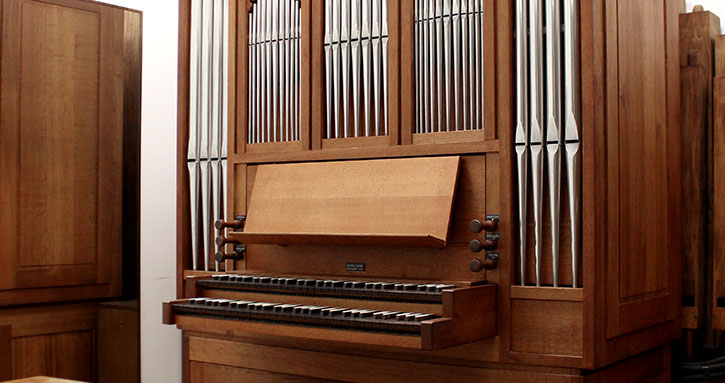Stunning Organ by German Master Builder Rudolf Janke Donated to Meadows by Wolfgang Rübsam
International musician donates instrument in honor of his SMU teacher, the late Dr. Robert T. Anderson

A beautifully crafted organ by master organ builder Rudolf Janke of Germany has been donated to SMU’s Meadows School of the Arts by Wolfgang Rübsam, a noted international musician, educator and recording artist.
The two-manual organ with six stops was created in 1974 for Rübsam and resided at his home in Indiana. Rübsam, whose teachers included the late Dr. Robert T. Anderson at SMU, recently moved and decided to donate the organ to SMU in Anderson’s memory. The organ was delivered and installed in a practice room in the Meadows School in August 2014. The dismantling, cleaning, moving, and installing of the instrument was done by the Buzard Organ Company from Champaign, Ill., under the direction of SMU piano technician David Brown.
“This inspiring instrument will now serve future generations of organ students at Meadows,” said Stefan Engels, professor of organ and Leah Fullinwider Centennial Chair of Music Performance. “SMU is most grateful for this generous and beautiful gift from Mr. Rübsam.”
A dedication ceremony is planned for spring 2015.
About the Janke organ
From 1948 until 1952, Rudolf Janke completed his apprenticeship with the organ-building firm Paul Ott in Hanover, Germany. He continued to work at Ott until 1956, when he completed the master examination in organ building in Ludwigsburg. Janke then developed his craft further while working in Lund, Sweden, for a year at the firm of Mårtensson. After his return to Germany he began to produce reed stops, and in 1958 he opened his own organ-building firm in Gertenbach, which was moved to Bovenden in 1963 and where it remained until 2009. Today his firm is located in Bühle (Northeim) and focuses on maintenance and restoration work. His son, Rainer, also became an organ builder and now works at the firm Freiburger Orgelbau Späth in Germany.
Janke’s style of organ building was clearly dominated by the ideals of the North and Middle German organ building tradition from the Baroque period. His organs almost always have mechanical tracker action with slider chests, and the consoles and specifications were also based on instruments from the Baroque. Janke preferred unequal temperaments, a slightly flexible but steady wind supply, a well-balanced specification, wide scaling for the 16- and 8-foot reeds, modern facades, which were neither historic nor in fashion, and a highly thorough voicing. He also advocated a new evaluation of the Organ Reform Movement in Germany.
About Wolfgang Rübsam
Wolfgang Rübsam studied under Helmut Walcha and Marie-Claire Alain, and at SMU with the late Dr. Robert T. Anderson. Upon winning the 1973 Grand Prix de
Chartres in Interpretation, he became professor of church music and organ at Northwestern University in Evanston, Ill. During his 23-year tenure, he also served as university organist at the University of Chicago at Rockefeller Memorial Chapel. From 1996 until his retirement in 2010, Rübsam was professor of organ at the University of Music in Saarbrücken, Germany. He is internationally known through more than 100 highly acclaimed recordings of organ repertoire from the Baroque and Romantic periods, as well as his Naxos Bach recordings on the modern piano. He gives frequent recitals and master classes in the United States and Europe and has served on the juries of the most prestigious international competitions. He is also a regular composer for Schott Music International.